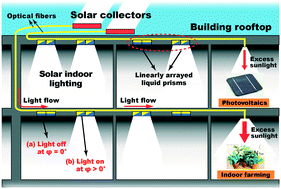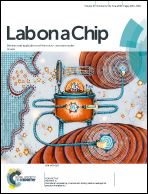Electrowetting-driven solar indoor lighting (e-SIL): an optofluidic approach towards sustainable buildings†
Abstract
Optofluidics is an emerging research field that combines the two disciplines of microfluidics and optics. By using microfluidic technologies for light control, optofluidic devices can offer several advantages over solid-type optical components, including optical-grade smoothness at the fluidic interface and a high degree of optical tunability without bulky and complex mechanical moving parts. These features have made optofluidic devices more versatile and reconfigurable to improve their optical performances. In this paper, we present a novel optofluidic sunlight manipulation technology for solar indoor lighting using the electrowetting principle. Rooftop sunlight is collected by a solar concentrator and guided to individual rooms along an optical fiber (waveguide) on the bottom of which tunable liquid prisms are linearly integrated. In the light-off mode, electrowetting controls the apex angle of the prisms to be φ = 0°. Under this condition, incoming sunlight experiences total internal reflection and thus keeps propagating along the optical fiber without leaking to the prism bottom for indoor lighting. In contrast, when liquid prisms are controlled to have the angle at φ > 0°, incoming sunlight is partially transmitted to the bottom surface of the arrayed prisms to contribute to interior illumination. Simulation studies validate that our electrowetting-driven solar indoor lighting (e-SIL) system is capable of variably tuning the lighting power from 0% to 98.6% of the input solar power by controlling the prism angle and varying the refractive index of prism materials. For experimental studies, we fabricated an array of 5 prisms filled with silicone oil and water. Using a fiber illuminator as a white light source that includes visible light with various incident angles, we have demonstrated two important lighting functions, (1) light on/off and (2) illumination power control. Lighting performance can be further enhanced by lowering the aspect ratio of the prism as well as increasing the number of prisms. The e-SIL technology based on tunable liquid prisms offers a new approach towards sustainable buildings that are able to reduce their electricity usage as well as provide a healthy and comfortable indoor environment under illumination of natural sunlight.



 Please wait while we load your content...
Please wait while we load your content...